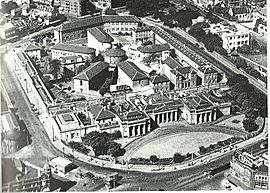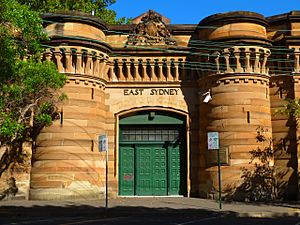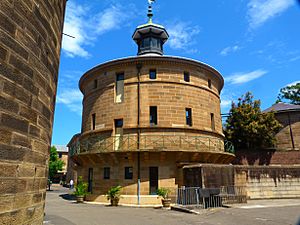Darlinghurst Gaol facts for kids

An aerial view of Darlinghurst Gaol, with the courthouse in the foreground, 1930
|
|
| Location | Darlinghurst, New South Wales |
|---|---|
| Coordinates | 33°52′47″S 151°13′07″E / 33.87972°S 151.21861°E |
| Status | Closed; repurposed as an art school |
| Opened | 7 June 1841 |
| Closed | 1914 |
The Darlinghurst Gaol was a famous old prison in Darlinghurst, New South Wales, Australia. It was built a long time ago and used to hold prisoners. Today, this historic building has a new life. It is now home to the National Art School, where students learn about art. The site is surrounded by Victoria, Burton, and Forbes streets. You can find its entrances on Forbes and Burton Streets.
History of Darlinghurst Gaol
Building work on Darlinghurst Gaol started in 1821. The prison wall was built between 1822 and 1824. Convicts, who were prisoners themselves, did all the hard work.
However, there wasn't enough money to finish the whole prison right away. So, the site stayed empty for 12 years. More construction began in 1836. Some of the cell blocks were finished by 1840. The prison was finally ready for use in 1841. The first prisoners arrived on June 7, 1841.
The entire prison complex was completed in 1885. Most of the gaol was built using large blocks of Sydney sandstone. These blocks were cut by convicts. You can still see markings made by the convicts on the upper part of the wall along Darlinghurst Road.
In the middle of the prison grounds, there is a tall, round chapel. Six rectangular cell blocks are built around it, like spokes on a wheel.
A famous Australian poet named Henry Lawson was held here for a time. He called the prison Starvinghurst Gaol. This was because the prisoners received very small amounts of food. The prison was closed in 1914.
Modern-Day Use
In 1921, the site was given to the New South Wales Department of Education. They changed the building so it could be used as the East Sydney Technical College. The National Art School was then started in 1922. Today, it is the only school using the historic Darlinghurst Gaol site.
Images for kids





